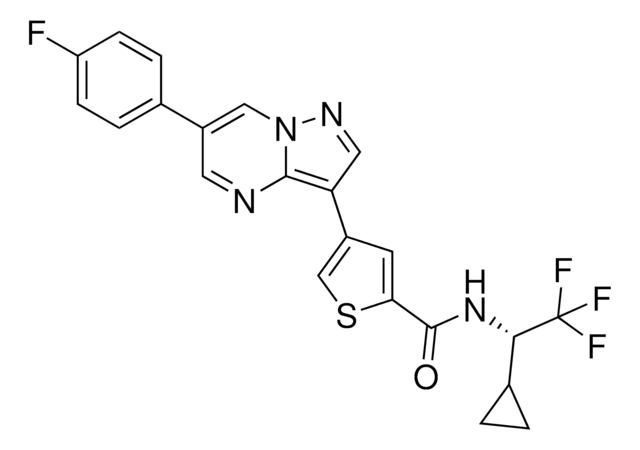SML1644
MRT68921 dihydrochloride
≥98% (HPLC)
Synonim(y):
N-[3-[[5-Cyclopropyl-2-[(1,2,3,4-tetrahydro-2-methyl-6-isoquinolinyl)amino]-4-pyrimidinyl]amino]propyl]-cyclobutanecarboxamide dihydrochloride
About This Item
Polecane produkty
Poziom jakości
Próba
≥98% (HPLC)
Postać
powder
warunki przechowywania
desiccated
kolor
white to beige
rozpuszczalność
H2O: 20 mg/mL, clear
temp. przechowywania
2-8°C
ciąg SMILES
CN(C1)CCC2=C1C=CC(NC3=NC=C(C4CC4)C(NCCCNC(C5CCC5)=O)=N3)=C2.[H]Cl.[H]Cl
InChI
1S/C25H34N6O.2ClH/c1-31-13-10-19-14-21(9-8-20(19)16-31)29-25-28-15-22(17-6-7-17)23(30-25)26-11-3-12-27-24(32)18-4-2-5-18;;/h8-9,14-15,17-18H,2-7,10-13,16H2,1H3,(H,27,32)(H2,26,28,29,30);2*1H
Klucz InChI
NLKPLTWKINJHCK-UHFFFAOYSA-N
Powiązane kategorie
Zastosowanie
- as a specific inhibitor of Unc-51-like kinase 1 (ULK1) in SH-SY5Y neuroblastoma cells
- as an inhibitor of ULK1 and ULK2 kinases in intrahepatic lymphocytes
- as a ULK1 inhibitor to test its effect on attenuation of autophagosome accumulation in ubiquitin-specific peptidase 24 (USP24) knockdown containing human neuroglioma H4 cells
Działania biochem./fizjol.
Kod klasy składowania
11 - Combustible Solids
Klasa zagrożenia wodnego (WGK)
WGK 3
Temperatura zapłonu (°F)
Not applicable
Temperatura zapłonu (°C)
Not applicable
Certyfikaty analizy (CoA)
Poszukaj Certyfikaty analizy (CoA), wpisując numer partii/serii produktów. Numery serii i partii można znaleźć na etykiecie produktu po słowach „seria” lub „partia”.
Masz już ten produkt?
Dokumenty związane z niedawno zakupionymi produktami zostały zamieszczone w Bibliotece dokumentów.
Nasz zespół naukowców ma doświadczenie we wszystkich obszarach badań, w tym w naukach przyrodniczych, materiałoznawstwie, syntezie chemicznej, chromatografii, analityce i wielu innych dziedzinach.
Skontaktuj się z zespołem ds. pomocy technicznej








